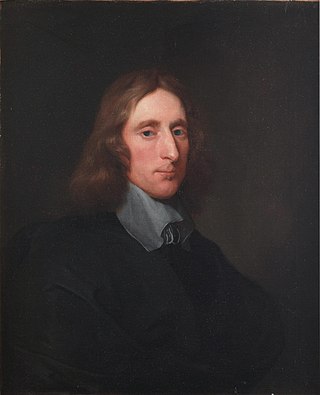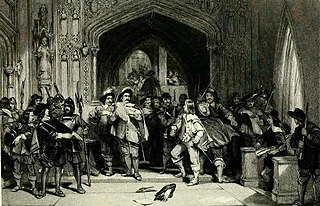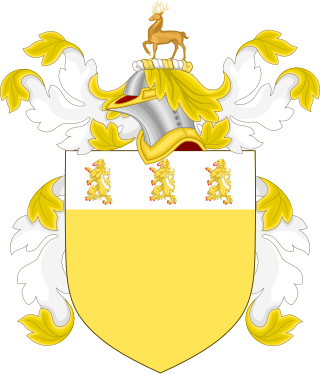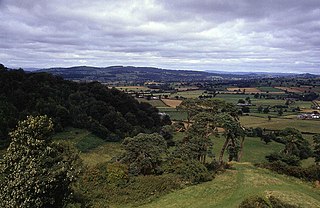Related Research Articles

Richard Cromwell was an English statesman who was the second and last Lord Protector of the Commonwealth of England, Scotland and Ireland and son of the first Lord Protector, Oliver Cromwell.

Sir Arthur Haselrig, 2nd Baronet was a leader of the Parliamentary opposition to Charles I and one of the Five Members whose attempted arrest sparked the 1642–1646 First English Civil War. He held various military and political posts during the 1639–1651 Wars of the Three Kingdoms but became an opponent of Oliver Cromwell during the Protectorate. In 1660, his actions inadvertently helped restore Charles II to the throne; unlike many senior Parliamentary leaders, his life was spared but he was confined to the Tower of London, where he died on 7 January 1661.

Pride's Purge is the name commonly given to an event that took place on 6 December 1648, when soldiers prevented members of Parliament considered hostile to the New Model Army from entering the House of Commons of England.

John Bradshaw was an English jurist. He is most notable for his role as President of the High Court of Justice for the trial of King Charles I and as the first Lord President of the Council of State of the English Commonwealth.

George Booth, 1st Baron Delamer, was an English landowner and politician from Cheshire, who served as an MP from 1646 to 1661, when he was elevated to the House of Lords as Baron Delamer.

Marbury is a small village located at SJ560457 in the civil parish of Marbury and District, formerly Marbury cum Quoisley, within the unitary authority of Cheshire East and the ceremonial county of Cheshire, England. It is administered jointly with the adjacent civil parishes of Norbury and Wirswall. The village lies around 3 miles (5 km) north east of Whitchurch in Shropshire and 7 miles (11 km) south west of Nantwich in Cheshire. Nearby villages include Malpas, No Man's Heath, Norbury, Wirswall and Wrenbury. The civil parish bordered Shropshire and covers 2,168 acres (877 ha); it also contains the small settlements of Hollins Lane, Marley Green and Quoisley, as well as parts of Hollyhurst and Willeymoor. The total population was just under 250 in 2001, and – combined with Wirswall – 352 in 2011.
The Bunbury Agreement of December 23, 1642 was a declaration of neutrality drawn up by some prominent gentlemen of the county of Cheshire shortly after the outbreak of the First English Civil War. Like similar attempts in Lancashire and other counties, it was ignored by both Parliament and Charles I, since the strategic importance of Cheshire and the city port of Chester meant national interests overruled local ones.

John Weaver was an English politician who sat in the House of Commons at various times between 1645 and 1659. He supported the Parliamentarian side in the Civil War

Rocksavage or Rock Savage was an Elizabethan mansion in Cheshire, England, which served as the primary seat of the Savage family. The house lies in ruins, at SJ526799 in Clifton. Built in the 1560s for Sir John Savage, Rocksavage was one of the great Elizabethan houses of the county, a leading example of the Elizabethan prodigy house; in 1674, it was the second largest house in Cheshire. James I visited in 1617. The house was abandoned after it passed into the Cholmondeley family early in the 18th century, and by 1782 only ruins remained.

Sir John Lisle was an English lawyer and politician who sat in the House of Commons at various times between 1640 and 1659. He supported the Parliamentarian cause in the English Civil War and was one of the regicides of King Charles I of England. He was assassinated by an agent of the crown while in exile in Switzerland.

Booth's Uprising, also known as Booth's Rebellion or the Cheshire Rising of 1659, was an unsuccessful attempt in August 1659 to restore Charles II of England. Centred on North West England and led by George Booth, it took place during the political turmoil that followed the resignation of Richard Cromwell as head of The Protectorate.
![<span class="mw-page-title-main">Thomas Mytton</span> Welsh [[Puritan]], soldier and politician (ca.1597-1656)](https://upload.wikimedia.org/wikipedia/commons/thumb/3/35/Thomas_Mytton_Harding.jpg/320px-Thomas_Mytton_Harding.jpg)
Major General Thomas Mytton, also spelt Mitton,, was a lawyer from Oswestry who served in the Parliamentarian army during the Wars of the Three Kingdoms and as MP for Shropshire in the First Protectorate Parliament.
Sir Thomas Tyrrell was an English judge and politician who sat in the House of Commons in 1659 and 1660. He fought on the Parliamentarian side in the English Civil War.
Sir Thomas Barnardiston, 1st Baronet was an English baronet, landowner, soldier and MP who sat in the House of Commons at various times between 1640 and 1659. He fought on the Parliamentary side in the English Civil War.
Thomas Pury was an English politician who sat in the House of Commons variously between 1640 and 1659. He fought on the Parliamentarian side in the English Civil War.
Richard Standish was an English politician who sat in the House of Commons in 1659 and 1660. He was a colonel in the Parliamentarian army in the English Civil War.

Richard Shuttleworth (1587–1669) was an English politician who sat in the House of Commons variously between 1640 and 1659.


The Battle of Winnington Bridge, often described as the last battle of the English Civil War, took place on 19 August 1659 during Booth's Uprising, a Royalist rebellion in north-west England and Wales.
References
- 1 2 Willis, Browne (1750). Notitia Parliamentaria, Part II: A Series or Lists of the Representatives in the several Parliaments held from the Reformation 1541, to the Restoration 1660 ... London. pp. 272–273.
- ↑ Local History Group & Latham (ed.), pp. 34, 36–38
- ↑ R. N. Dore, the Civil Wars in Cheshire, pg. 60-61
- ↑ R. N. Dore, the Civil Wars in Cheshire, p. 75